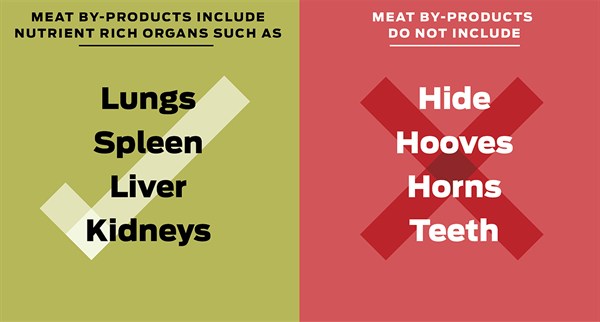Listen to “How To Choose A Better Kibble” on Spreaker.
General Tips:
- ALWAYS flip over the bag and read the full ingredient list. Do not rely on the front advertising panel to tell you what is in the food.
- Know that more expensive food does not necessarily mean that it is higher quality.
- Quality kibble generally cannot be found in grocery or hardware stores (or vet clinics 1 ).
- Include as much whole fresh food in your pet’s diet as you possibly can.
- Supplement & store your food properly → check out our “Supercharge Your Kibble” episode for more info.
Specific Things to Look Out For:
No Byproduct Meal
-
- Information released by companies like Purina suggest that byproducts are “primarily made up of nutrient rich organ meats such as lung, spleen, liver and kidneys”. 2
- If this were true byproducts would indeed be a nutritious addition to your pet’s food. Unfortunately, the variety of specific legal definitions of pet food ingredients allow pet food manufacturers an easy way to confuse the consumer into thinking that when they see byproducts listed on their food bag, it is not a bad thing.
- Information released by companies like Purina suggest that byproducts are “primarily made up of nutrient rich organ meats such as lung, spleen, liver and kidneys”. 2

Source: https://www.purina.com/dogs/dog-articles/understanding-dog-food/what-are-animal-by-products
- Susan Thixton from The Truth About Pet Food has recently written a wonderful article detailing this issue. To summarize, she points out that the above graphic is truthful only for Meat by-products and not for by-product meals (which by definition are allowed to include hide, hooves, horns, teeth, intestines, etc.) 3
No Propylene Glycol
- As a key component in antifreeze, most people feel that propylene glycol does not belong in their pet’s food
- However, the FDA’s Centre for Veterinary Medicine (CVM) has deemed it safe for use in dog and human food but not in cat foods because of it’s unfortunate tendency to cause Heinz body formations in red blood cells (RBC), reduce RBC survival time, render RBCs more susceptible to oxidative damage and to have other adverse effects. 4
- Again these findings were on cats, and so this ingredient is still allowed in human and dog foods.
No BHA, BHT or Ethoxyquin
- All three are synthetic chemical antioxidants used to preserve the fats & oils in pet food and used to lengthen their shelf life.
- BHA & BHT have both been named by the World Health Organization as suspicious cancer-causing compounds. They are used as cheaper synthetic alternatives to Vitamin E, a natural antioxidant.
- Ethoxyquin is allowed in pet foods even though the CVM has received reports that food with ethoxyquin caused “a myriad of adverse effects, such as allergic reactions, skin problems, major organ failure, behaviour problems, and cancer”.4
Their response to this information was to reduce the allowed amount in pet food from 150 ppm to 75 ppm. - BHA & BHT will be listed on the pet food label whereas Ethoxyquin generally won’t be. This is because if a company does not add ethoxyquin to their food after the individual ingredients have been processed, they do not need to include it on the label. The only way to know if they are using it as a preservative (generally ethoxyquin is used to prevent rancidity in fish meals) is to reach out to the company and ask or check their website.
No Corn or Soy
-
- Neither food constitutes a species appropriate diet for a wild carnivore. Wolves are not in the wild raiding corn & soy fields. It is true that dogs and wolves “only” share 99.8% of their DNA, so in case you are thinking that 0.2% makes them need to eat corn & soy let’s look at the main reasons I recommend avoiding it in your pet’s food.
- Corn is generally high in mycotoxins (toxic molds) and lectins (sticky molecules that often bind to the lining of the small intestine causing a decreased ability to absorb nutrients and an increased likelihood of dysbiosis)5
- Soy is a phytoestrogen, and a study showed that long-term ingestion of soy-based dog foods could lead to elevated T4 levels and negatively impact the dogs endocrine system.6
No DL-Methionine
-
- Methionine is a naturally occurring essential amino acid found in meat and fish products. It serves as a precursor to many amino acids, such as cysteine which is eventually converted into taurine
- So why do some kibbles need synthetic methionine (aka DL-Methionine) added in?? Because they actually have low meat/ fish contents despite advertising claims.7
- Rather than using quality carnivore appropriate ingredients many companies are relying on corn, soy, wheat and other inappropriate food sources to make up the majority of their foods.
- A food may contain meat ingredients, but the presence of DL-Methionine is a good indication that the food is not of the best quality.
Low Starch Content
-
- Unfortunately, this amount is hardly ever listed on the bag itself, and you will need to do some simple math to figure it out
- Formula for calculation is 100 – (protein +fat + moisture +ash)
- Not all foods list ash content so assume 8% if it is not listed8
- You want to choose a food with a low starch because dogs and cats convert starch into sugar. The higher the starch content, the higher the sugar content of the food.
- Watch this video for a more in-depth look at The Unknown Sugar In Pet Food
- Unfortunately, this amount is hardly ever listed on the bag itself, and you will need to do some simple math to figure it out
Understand the Label:
- I’m going to explain some basic labeling rules set out by the FDA (on a federal level) and the Association of American Feed Control Officials (AAFCO)9 & 10
- This part is a little tedious, but I think it is very important to understand that what your pet’s food is called directly related to its quality
- The 95% Rule
- This applies to food “consisting of primarily very few ingredients”9
- What it means if the food was called “Tuna Cat Food,” at least 95% of the product must be tuna. But not really, because this 95% does not count the water used for processing. When that water weight amount is taken out, the named product (in this case Tuna) must account for 70% of the final food.
- Furthermore, if there are two ingredients listed on the food bag such as “Tuna & Lamb Cat Food,” the two ingredients combined must make up 95% of the food (still not including water for processing).
- The 25% Rule aka The “Dinner” Rule
- If the food is called Tuna Dinner/Recipe/ Entree/ Formula/etc. Tuna only need comprise 25% of the food (again not including water for processing). When the water weight is considered the named ingredient, in this case, Tuna, need only comprise a mere 10% of the food.
- To further complicate matters, if there is more than one ingredient listed i.e., “Tuna & Lamb Cat Formula” the combined ingredients need to total 25% with neither ingredients comprising less than 3% of the diet.
- Ingredients are listed from greatest to least so in our Tuna & Lamb formula there is more Tuna than there is Lamb (min 3% not including water weight). When you factor the water for processing in, you can see how your food need only contain very, very small amounts lamb.
- The 3% Rule aka The “With” Rule
- Under this rule, a food called “Cat Food with Tuna” need only contain 3% Tuna (not factoring in water weight).
- Originally this rule was meant to apply only to highlighted ingredients not main components of the meal. However, the rule has been twisted and now applies to main components as well.
- The 95% Rule
-
- The Flavour Rule
- There are no minimum percentage requirements at all with this rule, making it (in my opinion) the scariest of all.
- According to this rule a product called “Cat Food with Tuna Flavour” only need to list what the source of the flavouring is in the ingredient list and need not contain that ingredient AT ALL
- The Flavour Rule
Want to connect with like-minded pet parents? Join our Facebook Group!
References:
- http://www.dogsnaturallymagazine.com/calling-bullhit-prescription-diet-dog-food/
- https://www.purina.com/dogs/dog-articles/understanding-dog-food/what-are-animal-by-products
- http://truthaboutpetfood.com/purina-says-by-products-are-nutrient-rich/
- https://www.fda.gov/animalveterinary/resourcesforyou/ucm047113.htm
- http://petfooddiva.com/corn-controversy-is-corn-really-bad-for-your-pet/
- https://www.ncbi.nlm.nih.gov/pmc/articles/PMC2698128/
- http://truthaboutpetfood.com/what-is-dl-methionine/
- Brown S., Taylor B., “See Spot Live Longer”, 2007 Creekobear Press, Eugene, OR USA, p 55
- https://www.fda.gov/AnimalVeterinary/ResourcesforYou/ucm047113.htm
- http://talkspetfood.aafco.org/readinglabels

